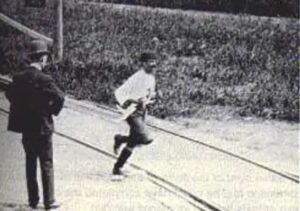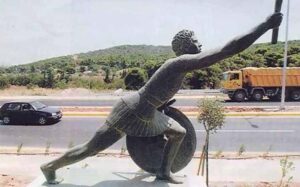marathon
 The Olympics…the dream of every serious athlete. While most of us will never get there, but many of us love to watch the best of the best athletes vie for the world title of Olympic Gold. These athletes would do just about anything to win. The men’s marathon in the 1904 Olympic Games was no exception.
The Olympics…the dream of every serious athlete. While most of us will never get there, but many of us love to watch the best of the best athletes vie for the world title of Olympic Gold. These athletes would do just about anything to win. The men’s marathon in the 1904 Olympic Games was no exception.
This race might have been the strangest race in history…going forward or backward. Only a few of the runners had any experience in running a race…much less a marathon, and the others were…well, “oddities” to say the least. That marathon was more of a comedy show than a serious race. The runners consisted of ten Greeks who had never run a marathon. Two of these belonged to the Tsuana tribe of South Africa and arrived barefoot to the race, and one competitor was a Cuban mailman who wore street clothing to the race. These days, they would almost be laughed off the track. I can just hear the shocked voices throughout the crowd at that race.

If you thought the apparel was odd…well hold on to your horses, because the “level of strange” is just getting started. The first to complete the race was American runner named Fred Lorz. Apparently, Lorz had dropped out of the race after nine miles and then hitch-hiked in a car. When the car broke down at the 19th mile, he jogged to the finish line. He was disqualified and banned from the competition for life. Sounds fair to me. The second to arrive, and the champion with Lorz disqualification, was Thomas Hicks. Ten miles from the finish line, he had almost given up, but his trainers urged him to continue. Still, it was an enormous struggle. He was given several doses of strychnine, a common rat poison, to help get him to the end of the race…WHAT!! When he reached the stadium, his trainers and supporters carried him to the finish line! It’s a wonder their “energy  boost” didn’t kill him!! Even though he got the gold medal that time, he never ran professionally again. A Cuban postman named Andarín Carvajal, ran the race in street clothes. To top it off, he had not eaten in 40 hours. Before a race!! Are you kidding me!! He got hungry and took a detour into an apple orchard during the race. He ate some rotten apples that gave him stomach cramps. Despite falling ill, he managed to finish in the fourth place!! Where were all the other racers, while he was taking his dinner break? If you ask me, this had to be the strangest marathon ever. It was almost like they were making it up as they went along.
boost” didn’t kill him!! Even though he got the gold medal that time, he never ran professionally again. A Cuban postman named Andarín Carvajal, ran the race in street clothes. To top it off, he had not eaten in 40 hours. Before a race!! Are you kidding me!! He got hungry and took a detour into an apple orchard during the race. He ate some rotten apples that gave him stomach cramps. Despite falling ill, he managed to finish in the fourth place!! Where were all the other racers, while he was taking his dinner break? If you ask me, this had to be the strangest marathon ever. It was almost like they were making it up as they went along.
 When we think of runners, most of us are impress, and rightly so. To run a race…especially a marathon…is an amazing feat. A marathon is 26.2 miles, but do you know why that is? Supposedly, the length of the race is a “tip of the hat” to a man named Pheidippides. According to legend, Pheidippides, an Athenian soldier, witnessed the combined Athenian and Spartan army’s victory over the Persians at Marathon. Then he supposedly ran 26 miles to Athens to deliver the news. When he arrived, he informed the Athenians, and then promptly perished of exhaustion. In his honor, marathon runners run 26.2 miles to remember that amazing feat, hoping not to share his fate in doing so. Another legend claims that the extra 0.2 miles were added during the 1908 Olympics so the race would end in front of Princess Mary’s pavilion. I’m not sure about the addition of the 0.2 miles, but the reality is that Pheidippides ran a lot further than 26 miles in his “death run” to spread the news of victory.
When we think of runners, most of us are impress, and rightly so. To run a race…especially a marathon…is an amazing feat. A marathon is 26.2 miles, but do you know why that is? Supposedly, the length of the race is a “tip of the hat” to a man named Pheidippides. According to legend, Pheidippides, an Athenian soldier, witnessed the combined Athenian and Spartan army’s victory over the Persians at Marathon. Then he supposedly ran 26 miles to Athens to deliver the news. When he arrived, he informed the Athenians, and then promptly perished of exhaustion. In his honor, marathon runners run 26.2 miles to remember that amazing feat, hoping not to share his fate in doing so. Another legend claims that the extra 0.2 miles were added during the 1908 Olympics so the race would end in front of Princess Mary’s pavilion. I’m not sure about the addition of the 0.2 miles, but the reality is that Pheidippides ran a lot further than 26 miles in his “death run” to spread the news of victory.
For that reason, the real Pheidippides probably wouldn’t have been impressed with someone who ran just 26.2 miles. That would have been child’s play to him. In reality, Pheidippides ran about 300 miles over the course of two days. It’s no wonder he passed away from exhaustion at the end of such a run. Pheidippides was a hemerodromos, or a military long-distance runner. Basically, he was a courier, but these days couriers use a  bicycle or car to carry their messages. Nevertheless, in ancient times, runners were the most efficient way to transmit messages over long distances, but Pheidippides’s legendary run was much, much longer than the average run. In fact, it was a “death run.”
bicycle or car to carry their messages. Nevertheless, in ancient times, runners were the most efficient way to transmit messages over long distances, but Pheidippides’s legendary run was much, much longer than the average run. In fact, it was a “death run.”
The actual task assigned to Pheidippides was to run from Athens to Sparta to ask for more soldiers to be sent. It was a task he carried out, and the Spartans agreed. However, they refused to fight until there was a full moon, as was their battle custom. That was six days away, and would be of no help, since the loss of life by then would be too great. So, Pheidippides turned around and ran back to Athens to inform his superiors of the delay. It reportedly took him two days to cover 300 miles, and it was at the end of this run that Pheidippides expired.
Supposedly, it was a different runner entirely who ran from Marathon to Athens to deliver the news about the victory. While remaining anonymous, this runner apparently still perished at the end of his journey, which is why his shorter run is still remembered. I suppose that does make the marathon a treacherous and dangerous race. Over time, Pheidippides’s ultra-marathon was combined with the anonymous runner’s feat. Maybe they thought it was impossible for a man to run 300 miles in two days, and since I’m not runner, I really couldn’t  say. For me, while I can and have regularly walked 10 to 15 miles in a day, to run even a mile would be a likely impossibility, so I have great respect for anyone who runs any distance, much less a marathon or even a half-marathon. I am not surprised that these men died at the end of their runs. Quite possibly, their water and even food supply was somewhat limited during their runs, and since I know how tired I am after walking 10 to 15 miles, I can almost imagine the exhaustion after running a marathon or half-marathon, but to run 300 miles over two days, well suffice it to say I would have dropped before the first day ended…which is probably why I don’t run…unless it is to get away from danger, hahaha!!
say. For me, while I can and have regularly walked 10 to 15 miles in a day, to run even a mile would be a likely impossibility, so I have great respect for anyone who runs any distance, much less a marathon or even a half-marathon. I am not surprised that these men died at the end of their runs. Quite possibly, their water and even food supply was somewhat limited during their runs, and since I know how tired I am after walking 10 to 15 miles, I can almost imagine the exhaustion after running a marathon or half-marathon, but to run 300 miles over two days, well suffice it to say I would have dropped before the first day ended…which is probably why I don’t run…unless it is to get away from danger, hahaha!!
 Through the ages, kids have thought that the work done by their parents is fun. They do their very best to mimic everything their parents do. The funny thing is that often, the things they see as being vitally important, are the mundane tasks that we do because we must, but try to get done with as quickly as possible, because they are so boring. I’ve never been able to figure out why those tasks catch the eye of our little ones, or why they place more importance on those tasks than some of the really important things we do every day. I suppose it is just the difference between the thoughts of a child and the thoughts of an adult.
Through the ages, kids have thought that the work done by their parents is fun. They do their very best to mimic everything their parents do. The funny thing is that often, the things they see as being vitally important, are the mundane tasks that we do because we must, but try to get done with as quickly as possible, because they are so boring. I’ve never been able to figure out why those tasks catch the eye of our little ones, or why they place more importance on those tasks than some of the really important things we do every day. I suppose it is just the difference between the thoughts of a child and the thoughts of an adult.

All in all, it’s not a bad thing that kids like to mimic their parents, because before long, they can do the real chores that they were pretending to do before…if they still want to by then. Of course, that is when your real work starts, because when you tell your child to do their chores, most kids take on a look of being instantly half sick. Their shoulders drop, along with their smile. They look like they have run a marathon, and here you are making them slave around the house, when you know that the only marathon they have been running is a marathon session on the play station. Funny, how that can suddenly be exhausting when you ask them to stop and do those chores.

Then, in your mind, you see that little kid, begging you to let them help, and if you were ever going to get anything done, you knew you were going to have to buy them a pint-sized version of whatever cleaning tool you were using. If you were ever going to get your work done, you were going to have to find a way for them to help you without actually using the tools you need, because you really don’t want to discourage them. The days that kids want to help are few and far between, after all, and before you know it, watching your kids doing the chores with a smile, are over.

